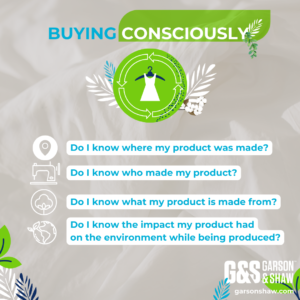Shop Consciously

To shop consciously means making thoughtful and sustainable choices that have a positive impact on the environment, workers, and your own well-being. Here are some tips for how to buy clothes consciously:
1. Research Sustainable Brands: Look for clothing brands that prioritize sustainability, ethical production, and transparency. Many brands now focus on eco-friendly materials, fair labor practices, and ethical supply chains. Websites and apps like Good On You can help you find and evaluate sustainable fashion brands.
2. Check for Certifications: Look for certifications like Fair Trade, Global Organic Textile Standard (GOTS), OEKO-TEX Standard 100, and others that indicate environmentally and socially responsible practices.
3. Quality Over Quantity: Invest in high-quality clothing that will last longer. While sustainable clothing may be more expensive upfront, it often pays off in the long run as you won’t have to replace it as frequently.
4. Secondhand and Vintage Shopping: Thrift stores, consignment shops, and online secondhand marketplaces are great places to find unique, affordable, and eco-friendly clothing options.
5. Minimalism: Adopt a minimalist approach to your wardrobe. Focus on versatile pieces that can be mixed and matched easily to create various outfits. This reduces the need for excessive clothing purchases.
6. Choose Timeless Styles: Trends come and go, but classic styles endure. Prioritize clothing items that won’t go out of fashion quickly, reducing the urge to constantly update your wardrobe.
7. Consider Materials: Choose natural, sustainable, and organic materials like organic cotton, hemp, Tencel, and recycled fabrics. Avoid synthetic materials like polyester and acrylic, which are derived from petroleum and take a long time to biodegrade.
8. Care for Your Clothing: Extend the lifespan of your clothing by following care instructions, repairing items when necessary, and avoiding excessive washing and drying.
9. Support Local and Independent Brands: Look for local and independent designers and brands that often have smaller carbon footprints and unique, handmade pieces.
10. Reduce Packaging: Be mindful of the packaging when you purchase clothing online. Opt for brands that use minimal and eco-friendly packaging or consider sending packaging back to the brand for recycling.
11. Understand Your Size: To reduce the likelihood of returns and exchanges (which can be wasteful), know your size and measure yourself accurately before buying online.
12. Swap and Share: Consider participating in clothing swaps with friends or community groups to refresh your wardrobe without buying new items.
13. Educate Yourself: Stay informed about the fashion industry’s impact on the environment and labor practices. Understand the issues and make informed decisions.
14. Calculate the Cost Per Wear: Before purchasing an item, consider how often you will wear it and calculate the cost per wear. This can help you make more thoughtful choices.
15. Advocate for Change: Support and advocate for policies and initiatives that promote sustainable fashion and fair labor practices in the industry.
By following these tips, you can make more conscious clothing choices that align with your values and contribute to a more sustainable and ethical fashion industry.

